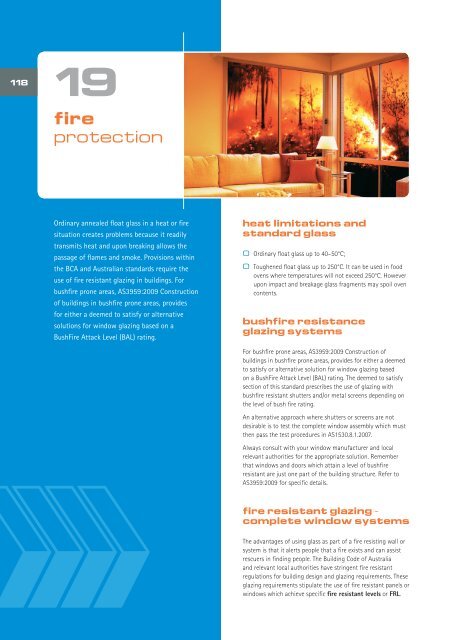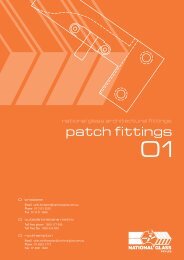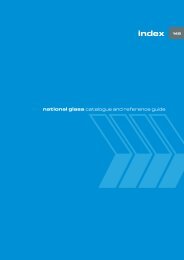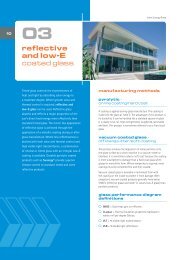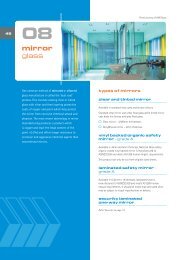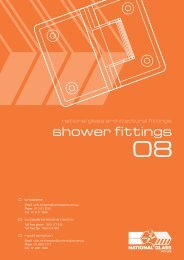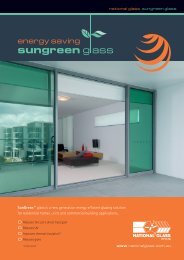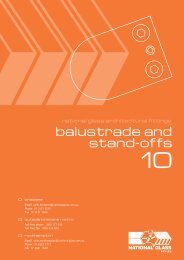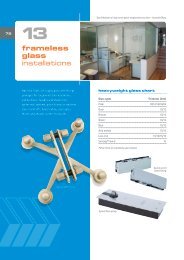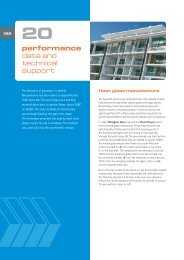19: Fire protection - National Glass
19: Fire protection - National Glass
19: Fire protection - National Glass
- No tags were found...
You also want an ePaper? Increase the reach of your titles
YUMPU automatically turns print PDFs into web optimized ePapers that Google loves.
118<strong>19</strong>fire<strong>protection</strong>Ordinary annealed float glass in a heat or firesituation creates problems because it readilytransmits heat and upon breaking allows thepassage of flames and smoke. Provisions withinthe BCA and Australian standards require theuse of fire resistant glazing in buildings. Forbushfire prone areas, AS3959:2009 Constructionof buildings in bushfire prone areas, providesfor either a deemed to satisfy or alternativesolutions for window glazing based on aBush<strong>Fire</strong> Attack Level (BAL) rating.heat limitations andstandard glass0 Ordinary float glass up to 40–50°C;0 Toughened float glass up to 250°C. It can be used in foodovens where temperatures will not exceed 250°C. Howeverupon impact and breakage glass fragments may spoil ovencontents.bushfire resistanceglazing systemsFor bushfire prone areas, AS3959:2009 Construction ofbuildings in bushfire prone areas, provides for either a deemedto satisfy or alternative solution for window glazing basedon a Bush<strong>Fire</strong> Attack Level (BAL) rating. The deemed to satisfysection of this standard prescribes the use of glazing withbushfire resistant shutters and/or metal screens depending onthe level of bush fire rating.An alternative approach where shutters or screens are notdesirable is to test the complete window assembly which mustthen pass the test procedures in AS1530.8.1.2007.Always consult with your window manufacturer and localrelevant authorities for the appropriate solution. Rememberthat windows and doors which attain a level of bushfireresistant are just one part of the building structure. Refer toAS3959:2009 for specific details.fire resistant glazing –complete window systemsThe advantages of using glass as part of a fire resisting wall orsystem is that it alerts people that a fire exists and can assistrescuers in finding people. The Building Code of Australiaand relevant local authorities have stringent fire resistantregulations for building design and glazing requirements. Theseglazing requirements stipulate the use of fire resistant panels orwindows which achieve specific fire resistant levels or FRL.
More importantly, in order for the window to pass the BCAregulations, the complete window assembly must have beentested. It must be identical in size, components and installationto a previously tested prototype. Obviously, it is advisable interms of cost to search for an approved fire rated prototype anddesign the window opening around the prototype.common terms usednon-insulatedWired glass is a typical non-insulating product. For clearthrough vision, clear polished wired is used. This product hasbeen tested to achieve –/60/–, or only a 60 minute integrity fireresistance in a steel frame. Wired glass upon expo sure, breaksbut the wire retains the glass fragments in place. Wired glass isnot a Grade A safety glass.1<strong>19</strong>0 FRL – or ‘fire resistant levels’ refers to the grading periodsin minutes of fire windows for the following criteria;0 Structural adequacy – refers to the ability to maintainstability and adequate load bearing capacity as determinedby AS1530.4;0 Integrity – refers to the glazing’s ability to resist thepassage of flames and hot gases as specified in AS1530.4;0 Insulation – refers to the ability to maintain a temperatureon the glass surface not exposed to the fire below the limitsas specified in AS1530.4;0 Specifications for FRL should be expressed in theabove order – e.g. –/60/30. This for example, refers to nostructural adequacy requirement, a 60 minute integrity and30 minute insulation rating for a fire resistant glazing.insulatedThere are two types of insu lating glass products:0 The first type, glass such as Pyrobel® manufacturedby Glaverbel, uses a clear intumescent interlayer in alaminated or multilaminated glass make-up. Upon heatingin excess of 120°C, the interlayer turns into a rigid andopaque fire shield. The higher the FRL requirement, thethicker the glass and the greater the number of interlayers;0 The second type consists of a gel interlayered glass in asealed glazing unit. The cavity is filled with a clear heatabsorbing gel. Both products can provide high levels ofintegrity and insulation and satisfy Grade A safety glassrequirements.defining an FRL specification– / 60 / 30– (no requirement) 60 minutes 30 minutesStructural Integrity Insulationadequacy requirements requirementspyrobel®product types by FRLclassificationsprinklers and non-firerated windowsThe use of sprinklers or deluge systems with non-fire ratedglass or windows present some issues of concern. One reasonis that we are relying on a mechanical system that may fail.Mechanical fault is also the result of a poor maintenanceregime. Secondly, thermal shock associated with glass breakingdue to excessive differences in tempera ture may result inflames and smoke breaching the opening. Therefore, wheresprinklers are used, it is best to rely on a tested fire ratedwindow assembly to meet fire rating requirements.fire resistant glazing –types of glass<strong>Fire</strong> resistant glazing systems can be categorised intonon-insulated and insulated units. As stated, the fire resistantlevel or FRL can only be attained if the complete unit has beentested previously as a prototype. Framing for fire resistantwindows is either made of steel or hardwood timber. Hardwoodtimber frames are naturally insulating while steel can be madeeither insulating or non-insulating.pyrobelite0 EW 30/7 – 30 minutes integrity / low radiation glass.pyrobel0 EI 30/12 – 30 minutes integrity / 30 minutes insulation;0 EI 30/16 – 60 minutes integrity / 30 minutes insulation;0 EI 60/21 – 60 minutes integrity / 60 minutes insulation(see also page 120);0 EI 60/25 – 60 minutes integrity / 60 minutes insulation;0 EI 90/35 – 90 minutes integrity / 90 minutes insulation(see also page 120);0 EI 120/52 – 120 minutes integrity / 120 minutes insulation.glazing notesFor external applications, Pyrobel® is available as external gradewith a UV filter. Pyrobel® external grade must be correctlyorientated according to its label. The glazing must be eitherfully bedded using neutral cure silicone or installed in drainedand ventilated rebates and carefully sealed with a neutral curesilicone capping. Outside applications are only permitted if thetemperature limit of 40ºC is not likely to be exceeded.
This page shows various Pyrobel® products and summaries of their respective fire test reports.120Pyrobel® is a multilaminated glass assembled with clear intumescent interlayers. In case of fire, these interlayers expand at around120˚C and transform into a rigid and opaque fire shield, which enables the glazing to meet the integrity and insulation criteria,according to BS 476: Part 22: <strong>19</strong>87 which is recognised by NATA in Australia.pyrobel® EI 60/21FRL –/60/60 (60 minutes integrity / 60 minutes insulation)Performances:Glazing type Single Single DoubleGlazing location Internal External ExternalThickness 21mm 25mm 6/12/25 = 43mmThickness tolerance +/–2mm +/–2mm +/–3mmWeight 47kg/m 2 55kg/m 2 70kg/m 2Minimum size available No min No min 200mm x 400mmDimension tolerance +/–2mm +/–2mm +/–3mmLight transmission 83% 82% 73%K-value 5.2 W/m 2 K 5.0 W/m 2 K 2.7 W/m 2 KSafety Grade A (AS1288) Yes Yes YesSound reduction 41dB 42dB 44dBSummary of fire test reports according to BS 476: Part 22: <strong>19</strong>87Institute LPC LPC LPCReport/Assessment TE81342/340 CC84562A CC84562BDate 13/8/91 23/2/94 23/2/94Framework Hardwood Hardwood HardwoodMaximum glass size 1200mm x 2300mm 1200mm x 2000mm 1200mm x 2000mmIntegrity 73 minutes >60 minutes >60 minutesInsulation 73 minutes >60 minutes >60 minutesInstitute LPC LPCReport/Assessment 342.2Date 27/9/91FrameworkSteelMaximum glass size1200 x 2300mmIntegrity>60 minutesInsulation>60 minutespyrobel® EI 90/35FRL –/90/90 (90 minutes integrity / 90 minutes insulation)Performances:Glazing type Single Single DoubleGlazing location Internal External ExternalThickness 35mm 39mm 6/12/39 = 57mmThickness tolerance +3/–1mm +3/–1mm +4/–2mmWeight 80kg/m 2 88kg/m 2 103kg/m 2Minimum size available No min No min 200mm x 400mmDimension tolerance +/–2mm +/–2mm +/–3mmLight transmission 82% 81% 72%K-value 4.9 W/m 2 K 4.7 W/m 2 K 2.6 W/m 2 KSafety Grade A (AS1288) Yes Yes YesSound reduction 43dB 44dB 46dBSummary of fire test reports according to BS 476: Part 22: <strong>19</strong>87Institute LPC LPC LPCReport/Assessment CC83466 CC84731A/B CC84731A/BDate 15/3/93 25/5/94 25/5/94Framework Steel Steel SteelMaximum glass size 1000 x 2200mm 1000 x 2200mm 1000 x 2200mmIntegrity 104 minutes >90 minutes >90 minutesInsulation 98 minutes >90 minutes >90 minutes
heat resistant glassproductsRefers to types of glass which have been designed to handletemperatures in excess of 250°C such as Neoceram, Vycorand Neotherm® for specific applications. It also refers toapplications where there are no BCA, legislative or AustralianStandard requirements but where the use of a heat resistantglass is recommended.neoceramThis is a 5mm thick ‘brownish tinged’ transparent ceramic glasswith very low thermal expansion and mechanical resistance.Suited for food ovens, fire places, combustion wood heaters andstoves where temperatures do not exceed 700°C. (This productcan withstand short term temperatures of 800°C). Its cuttingand breakage characteristics are similar to annealed glass.Edges should be arrised prior to installation. When installingNeoceram, care must be taken to ensure the edges are notdamaged. They must be protected by means of fire resistantcord or ribbon, glass fibre or some other non combustiblematerial to prevent breakage. Direct metal to glass contactmust be avoided. Sheet sizes are 880mm x 1590mm.internal glass claddingSpecial note should be made here with regards to <strong>protection</strong>of combustible surfaces near cooking appliances. The useof painted glass panels for kitchen splashback applicationsrequires that this glass meets the requirements underAS4551/AG101 and AS5601/AG601. Suppliers of painted glassproducts should have accredited testing results to verifycompliance to these standards.These standards are designed to prevent excessive heat andpossibly fire in combustible materials supporting the wallcovering. If testing evidence is not available fire resistantmaterials must be installed behind glass panel.121vycorAvailable in 3mm and 6mm thicknesses, Vycor is a silicatebased glass with a long term operating temperature of 1200°C.It is available in maximum sizes of 300mm x 300mm.neotherm® observation glassNeotherm® is a furnace observation glass for observingmolten substances during melting processes. In view of medicalexperiences and technical factors, a furnace observationglass should meet the most important requirements, that of<strong>protection</strong> against harmful radiation as well as field provenrecognition and evaluation of molten substances. Neotherm®is the first glass meeting both requirements and offeringeye <strong>protection</strong> as required in practice. It absorbs the harmfulradiation within the infrared range of 780nm and 2000nm,allowing the operator at the same time to recognise differencesin molten substances. Available in gold filters for additional<strong>protection</strong> and non gold filters, furnace observation glass isused in protective devices such as hand shields, goggles, headshield and glare <strong>protection</strong> for cranes etc.Neotherm® is not designed for <strong>protection</strong> againstultraviolet radiation in welding operations.Refer “Welding <strong>Glass</strong>” on page 62 for more information.


